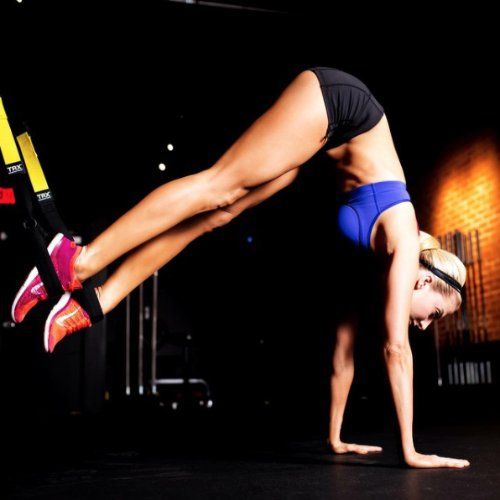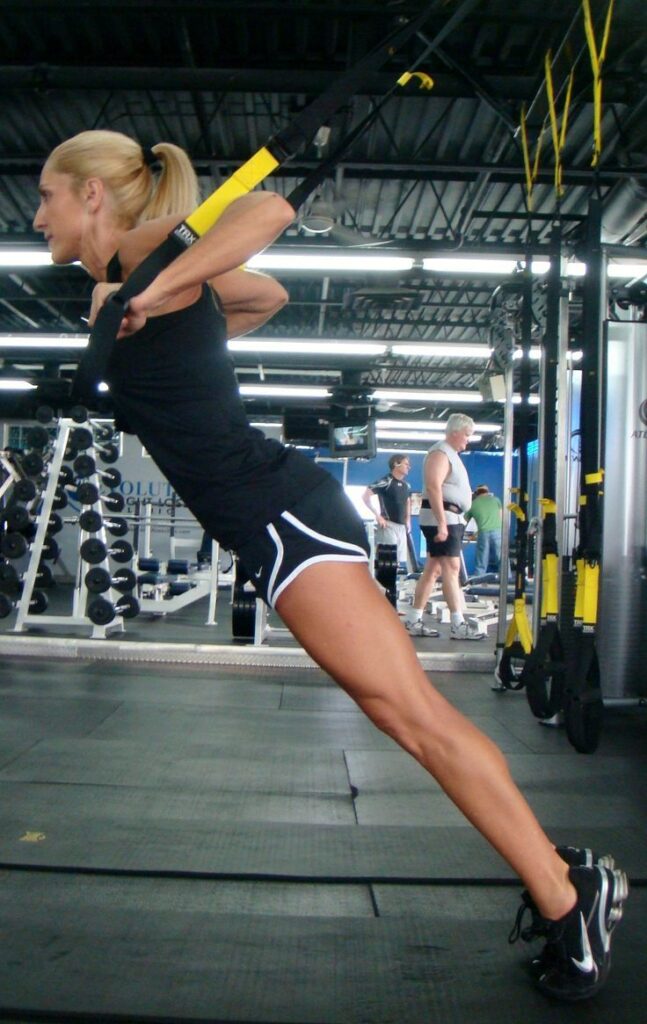Beginner TRX Workouts: Start Your Fitness Journey:

Total Resistance Exercises (TRX) is a form of suspension training that utilizes body weight as resistance to build strength, balance, flexibility, and core stability. This versatile training system was developed by Randy Hetrick, a former Navy SEAL, and has since become a popular choice for fitness enthusiasts around the world.
Table of Contents
TRX suspension training uses gravity for resistance, which means that you’re using your own body weight. However, your distance from the anchor point of the TRX can make an exercise easier or exponentially more challenging. You also may find that the TRX enables you to find more range of motion, support, or resistance for your workout; depending on your fitness level and body position.
TRX Workout Plan for Beginners
This workout is a circuit-based workout, meaning that you’ll go down the list of exercises. You’ll complete 12-15 reps of the first exercise, move onto the second, then the third, etc. until you reach the end of the circuit. You’ll rest for 60-90 seconds and complete the circuit 1-2 more times through.
Warm up 5-7 minutes with moderate cardio
Complete the following moves in a circuit,
moving quickly from one exercise to the next.
ASSISTED SQUAT AND NARROW ROW X 12
ALTERNATING LUNGE X 20 TOTAL
WIDE ROW X 15
BICEPS CUL X 15
CHEST PRESS X 15
TRICEPS EXTENSION X 15
MOUNTAIN CLIMBERS X 30 SECONDS
PLANK X 30 SECONDS
Rest 60-90 seconds and repeat the circuit
1-2 more times.
Importance of Beginner TRX Workouts
Starting with TRX workouts as a beginner is an excellent way to lay a solid foundation for overall fitness. The TRX system allows for a wide range of exercises that can be tailored to various fitness levels, making it ideal for those new to exercise or those looking to switch up their routine.
Benefits of Using TRX Suspension Training
TRX training offers numerous benefits, including improved core strength, enhanced flexibility, and increased functional strength. The system allows for a full-body workout that engages multiple muscle groups simultaneously, which can lead to more efficient workouts and faster results.
Understanding TRX Training

What is TRX Training?
TRX Training is a form of bodyweight exercise that leverages the TRX Suspension Trainer to create resistance. By suspending the straps from an anchor point, users perform exercises that challenge their stability and strength. This method is effective for both beginners and advanced athletes due to its scalability.
History and Development of TRX
The TRX system was invented in 1997 by Randy Hetrick while serving in the Navy SEALs. Hetrick designed the TRX Suspension Trainer to maintain physical conditioning during deployment. After its successful implementation in military training, it evolved into a commercial product and gained widespread popularity in the fitness industry.
Key Components of TRX Equipment
The TRX Suspension Trainer consists of two adjustable straps with handles that can be anchored to various surfaces. The system also includes a door anchor, suspension anchor, and foot cradles for different types of exercises. These components work together to provide a versatile workout experience.
Getting Started with TRX

How to Set Up Your TRX
Setting up the TRX Suspension Trainer involves securing the straps to a sturdy anchor point, such as a door frame, ceiling mount, or tree. Ensure the straps are adjusted to the appropriate length based on the exercise you plan to perform. Proper setup is crucial for safety and effectiveness.
Safety Precautions
Before starting your TRX workout, it’s important to ensure the anchor point is secure and stable. Additionally, inspect the TRX equipment for any signs of wear and tear. Always maintain proper form during exercises to avoid injury and maximize the benefits.
Choosing the Right TRX Kit
When selecting a TRX kit, consider your fitness goals and the space available for setup. The basic kit includes the TRX Suspension Trainer and necessary accessories, while advanced kits may offer additional components such as workout guides or specialized anchors.
Basic TRX Exercises

Introduction to Basic Moves
For beginners, starting with basic TRX exercises is essential to build strength and confidence. These foundational movements help develop proper form and technique, which is crucial for advancing to more complex exercises.
TRX Squats
The TRX Squat is a fundamental exercise that targets the lower body. To perform this move, hold the TRX handles with arms extended and feet shoulder-width apart. Lower your body by bending your knees and pushing your hips back, then return to the starting position.
TRX Rows
TRX Rows focus on the upper back and biceps. Begin by leaning back with arms extended and feet anchored. Pull your body towards the TRX handles by bending your elbows and squeezing your shoulder blades together, then slowly lower back to the starting position.
TRX Chest Press
The TRX Chest Press works the chest, shoulders, and triceps. Start by facing away from the anchor point with the TRX handles in your hands and arms extended. Lower your chest towards your hands by bending your elbows, then press back up to the starting position.
TRX Lunges
TRX Lunges target the legs and glutes. Stand with one foot forward and the other foot in the TRX foot cradle. Lower your body into a lunge position by bending both knees, keeping the front knee aligned with the ankle. Push back up to the starting position.
TRX Planks
The TRX Plank is excellent for core strength. Place your feet in the TRX foot cradles and assume a plank position with your body in a straight line from head to heels. Hold this position for a set amount of time, engaging your core throughout.
Advanced TRX Exercises
Introduction to Advanced Moves
Once you’ve mastered basic TRX exercises, you can progress to more advanced moves that challenge your strength, stability, and coordination. These exercises require a higher level of skill and control.
TRX Single-Leg Squats
TRX Single-Leg Squats target the legs and core. Stand on one leg with the other leg extended in front of you, holding the TRX handles for support. Lower your body into a squat position on the standing leg, then return to the starting position.
TRX Atomic Push-Ups
TRX Atomic Push-Ups combine push-ups with a core challenge. Start in a push-up position with your feet in the TRX foot cradles. Perform a push-up, then draw your knees towards your chest before returning to the push-up position.
TRX Pike
The TRX Pike targets the core and shoulders. Begin in a plank position with feet in the TRX foot cradles. Lift your hips towards the ceiling, forming a pike position, then lower back to the plank position.
TRX Mountain Climbers
TRX Mountain Climbers are a dynamic exercise that engages the core and cardiovascular system. Start in a plank position with feet in the TRX foot cradles. Alternately drive your knees towards your chest in a running motion.
TRX Burpees
TRX Burpees combine strength and cardio. Start by performing a TRX squat, then place your hands on the ground and jump your feet back into a plank position. Perform a push-up, then jump your feet back to your hands and finish with a jump.
Designing a TRX Workout Routine
Warm-Up and Stretching
Warming up before a TRX workout is crucial to prepare your muscles and joints. Include dynamic stretches and light cardio to increase blood flow and reduce the risk of injury.
Full-Body TRX Routine
A full-body TRX routine includes exercises that target all major muscle groups. Incorporate a mix of upper body, lower body, and core exercises to ensure a balanced workout.
Upper Body TRX Routine
Focus on exercises that work the chest, back, shoulders, and arms. Examples include TRX Rows, TRX Chest Press, and TRX Bicep Curls.
Lower Body TRX Routine
Include exercises that target the quads, hamstrings, glutes, and calves. TRX Squats, TRX Lunges, and TRX Single-Leg Squats are excellent choices.
Core-Focused TRX Routine
A core-focused routine emphasizes exercises that strengthen the abdominal and lower back muscles. TRX Planks, TRX Pike, and TRX Mountain Climbers are effective core exercises.
Sample 30-Minute Beginner Routine
A sample 30-minute beginner routine might include a 5-minute warm-up, 20 minutes of alternating exercises (e.g., TRX Squats, Rows, and Chest Press), and a 5-minute cool-down with stretching.
Tips for Progression and Variations
To progress in your TRX training, gradually increase the intensity by adjusting the angle of your body, adding more repetitions, or incorporating advanced exercises. Variations can include changing hand or foot positions, increasing the range of motion, or incorporating additional equipment.
Common Mistakes and How to Avoid Them
Incorrect Form and Its Consequences
Maintaining proper form is critical in TRX training. Common mistakes include arching the back during planks, improper knee alignment during squats, and not fully extending arms during rows. These errors can lead to poor results and increase the risk of injury. Focus on proper alignment, controlled movements, and using a mirror or recording yourself to check your form.
Overtraining and Injury Risks
Overtraining can lead to fatigue and increase the risk of injury. Ensure adequate rest between workouts and listen to your body. Symptoms of overtraining include persistent soreness, decreased performance, and fatigue. Incorporate rest days and vary your routine to prevent overtraining.
Not Using the TRX Properly
Incorrect use of the TRX Suspension Trainer, such as using it with insufficient stability or not adjusting the straps correctly, can lead to ineffective workouts and potential injuries. Always ensure the equipment is securely anchored and properly adjusted for each exercise.
Incorporating TRX into Your Fitness Plan
Combining TRX with Cardio
TRX workouts can be combined with cardio exercises to enhance overall fitness. Incorporate activities like running, cycling, or rowing between TRX sets to improve cardiovascular health and endurance.
Integrating TRX with Strength Training
Integrating TRX exercises with traditional strength training can provide a balanced approach to fitness. Alternate between TRX workouts and free weights or resistance bands to target different muscle groups and prevent workout monotony.
Setting Realistic Fitness Goals
Setting realistic and achievable fitness goals is essential for progress. Establish short-term and long-term goals based on your fitness level, such as improving endurance, increasing strength, or mastering specific TRX exercises. Regularly reassess and adjust your goals as needed.
TRX and Nutrition
Importance of Nutrition for Fitness
Proper nutrition supports overall fitness and performance. A balanced diet rich in proteins, carbohydrates, fats, vitamins, and minerals provides the energy needed for workouts and aids in recovery and muscle growth.
Pre-Workout and Post-Workout Nutrition
Pre-workout nutrition should include easily digestible carbohydrates and some protein to fuel your workout. Post-workout nutrition should focus on protein and carbohydrates to aid in muscle repair and replenish glycogen stores. Examples include a smoothie with protein powder and fruit or a meal with lean protein and vegetables.
Hydration Tips
Staying hydrated is crucial for optimal performance and recovery. Drink water throughout the day and ensure adequate hydration before, during, and after your TRX workouts. For longer or more intense sessions, consider an electrolyte-rich drink.
Real-Life Success Stories
Case Study 1: Beginner’s Transformation
Meet Jane, who began TRX training as a complete beginner. With consistent workouts and a balanced diet, Jane improved her strength and endurance significantly over six months. She lost 15 pounds and reported increased energy and confidence.
Case Study 2: Overcoming Fitness Plateaus
John, a seasoned athlete, faced a fitness plateau. Incorporating TRX exercises into his routine helped him break through this plateau. By adding TRX Rows and Atomic Push-Ups, he enhanced his upper body strength and achieved new personal records.
Case Study 3: TRX for Rehabilitation
Sarah used TRX training as part of her rehabilitation program after knee surgery. The low-impact exercises allowed her to regain strength and mobility without placing undue stress on her recovering knee. Her physical therapist recommended TRX exercises to aid in her recovery and prevent future injuries.
Expert Insights
Interview with a TRX Trainer
We spoke with Alex, a certified TRX trainer, who shared insights on the benefits of TRX for beginners. According to Alex, “TRX training is excellent for developing functional strength and stability. It’s adaptable to various fitness levels, making it ideal for beginners. Proper form and progression are key to success.”
Advice from Fitness Experts
Fitness expert Dr. Emily Johnson emphasizes the importance of consistency and gradual progression. “Start with basic exercises and focus on form. As you become more comfortable, you can increase the intensity and complexity of your workouts. Combining TRX with other forms of exercise can also enhance your results.”
Common Questions and Answers
- Q: How often should I do TRX workouts as a beginner? A: Aim for 2-3 TRX sessions per week, allowing for rest days in between. Gradually increase frequency as you build strength and endurance.
- Q: Can I use TRX if I have previous injuries? A: Consult with a healthcare provider before starting any new exercise program. TRX can be adapted for rehabilitation, but it’s important to ensure exercises are safe for your specific condition.
Resources and Tools
Recommended TRX Equipment and Accessories
- TRX Suspension Trainer: The core equipment for TRX training.
- Door Anchor: For setting up the TRX in home environments.
- TRX Mat: Provides a stable surface for floor exercises.
- TRX Xtender: For increased anchor flexibility.
Useful Apps and Websites for TRX Workouts
- TRX Training App: Offers guided workouts and exercise tutorials.
- MyFitnessPal: Useful for tracking nutrition and fitness progress.
- Fitness Blender: Provides free workout videos, including TRX routines.
Books and Guides on TRX Training
- “TRX Training: The Ultimate Guide” by Peter T. Rizzo
- “Suspension Training: The Ultimate Guide to TRX Training” by Matt Miller
Conclusion
Summary of Key Points
TRX training is a versatile and effective workout system that offers numerous benefits for beginners. By starting with basic exercises, designing a balanced workout routine, and incorporating proper nutrition, beginners can achieve significant fitness improvements.
Encouragement for Getting Started
Whether you’re new to exercise or looking to diversify your routine, TRX training is a fantastic option. Begin with the basics, stay consistent, and enjoy the journey towards a stronger, more balanced you.
Call to Action for Further Learning
Explore additional resources, consult fitness experts, and continue learning about TRX training to maximize your results. Embrace the challenge and make TRX a valuable part of your fitness journey.
- Also Read :
- Discover the Best Kettlebell Workouts for All Levels
- Improve Your Swing with Golf Flexibility Exercises
- Core and Flexibility Workout for a Stronger Body
- Zone 2 Cardio: Benefits, Heart Rate Zones, and Training Guide
Common Questions and Answers:
How often should I do TRX workouts as a beginner?
Aim for 2-3 TRX sessions per week, allowing for rest days in between. Gradually increase frequency as you build strength and endurance.
Can I use TRX if I have previous injuries?
Consult with a healthcare provider before starting any new exercise program. TRX can be adapted for rehabilitation, but it’s important to ensure exercises are safe for your specific condition.
